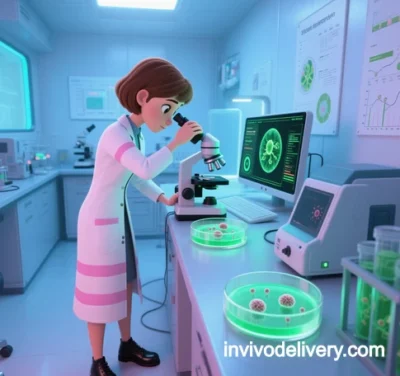
In Vivo Delivery Technologies for Hematopoietic Stem Cell Editing: Applications and Advances
(As of May 2025)
I. Technology Platforms: From Lipid Nanoparticles to Targeted Delivery
1. Breakthroughs in Lipid Nanoparticles (LNPs)
- Antibody-Targeted Delivery:
CD117-targeted LNPs (e.g., CD117/LNP-mRNA) enable hematopoietic stem cell (HSC)-specific delivery. For example, the University of Pennsylvania’s CD117/LNP system successfully delivered base editor ABE8e mRNA and sgRNA in vivo, directly editing the HBG locus in HSCs to restore fetal hemoglobin (HbF) expression, treating sickle cell disease (SCD) and β-thalassemia (TDT). - Antibody-Free Targeting:
Advanced LNPs (e.g., LNP-168-ABE8e) optimize lipid head and tail structures, achieving over 90% HSC editing efficiency in humanized mouse models.
2. Viral Vector Innovations
- Engineered adeno-associated virus (AAV) and lentiviral vectors (LVs) target HSCs. AAV6 vectors combined with zinc finger nuclease (ZFN) mRNA achieve 15–40% editing efficiency for site-specific gene insertion in vivo.
3. Peptide-RNA Fusion Technologies
- Peptide-Assisted Genome Editing (PAGE) uses cell-penetrating peptides (CPPs) to deliver CRISPR-Cas9 ribonucleoproteins (RNPs) to HSCs, bypassing viral immunogenicity and showing promise for primary immunodeficiency treatment.
II. Applications: From Blood Disorders to Immune Diseases
1. Hemoglobinopathies
- Sickle Cell Disease:
CD117/LNP-delivered ABE8e mRNA converts pathogenic HBB mutations to benign variants in mice, eliminating sickle cells and restoring functional hemoglobin in over 90% of cases. - β-Thalassemia:
Optimized LNP-168-ABE8e induces γ-globin (HBG1/2) expression in TDT patient HSCs, correcting globin chain imbalance and enabling potential “single-shot” cures without transplantation.
2. Immunodeficiencies and Cancer
- Severe Combined Immunodeficiency (SCID):
CD117/LNP-delivered PUMA mRNA selectively clears patient HSCs, creating niches for healthy donor HSC engraftment without chemotherapy, reducing secondary cancer risks. - In Vivo CAR-T Engineering:
Tessera Therapeutics uses LNPs to deliver Gene Writers™ and CAR genes to T cells, enabling same-day tumor clearance in mice and advancing solid tumor therapies.
III. Advantages: Overcoming Traditional Therapy Limits
- Eliminating Ex Vivo Manipulation:
In vivo editing replaces costly, complex ex vivo processes (e.g., HSC extraction, GMP manufacturing, and preconditioning chemotherapy), reducing costs from 2Mtounder10K per treatment. - Reduced Toxicity:
Non-viral LNPs minimize immunogenicity and off-target effects, with long-term studies showing no increased carcinogenic risk. - Versatility:
Single platforms support multiple editors (base editing, prime editing, CRISPR-Cas9). For example, prime editors repair IL2RG in HSCs to treat SCID.
IV. Challenges and Solutions
1. Delivery Efficiency and Specificity
- Challenge: HSCs comprise 0.01% of bone marrow cells and remain quiescent, limiting traditional LNP targeting.
- Progress: Antibody engineering (CD117/CD34 targeting) and lipid optimization boost in vivo editing efficiency from 5% to 90%.
2. Immunogenicity and Toxicity
- Challenge: Cas9 antibodies and high-dose LNP hepatotoxicity.
- Progress: Short-lived mRNA, self-inactivating editors (e.g., HypaCas9), and liver-evading LNPs (adjusted PEG lipids) mitigate risks.
3. Scalability and Regulation
- Challenge: Lack of standardized LNP production.
- Progress: Blockchain-powered microfluidic factories (e.g., Ginkgo BioWorks’ BioFabs) cut production cycles to 72 hours and costs to $80K per course.
V. Future Directions
1. Multimodal Delivery Systems
- Quantum dot-labeled LNPs enable real-time tracking of editing; Opto-LNPs use near-infrared light to spatiotemporally control enzyme activity.
2. AI-Driven Design
- Generative AI (e.g., AlphaFold3) predicts LNP-receptor interactions to design novel lipids, while federated learning accelerates lipid library optimization.
3. Clinical Translation and Expansion
- 2025 Milestone: First in vivo HSC therapy (ET-101 for SCD) enters Phase III trials; Tessera initiates Gene Writing™ trials for AATD.
- 2030 Vision: In vivo editing to address 50%+ inherited blood disorders and age-related dysfunctions (e.g., myelofibrosis).
Conclusion
In vivo delivery technologies are shifting HSC editing from ex vivo transplantation to in vivo cures, driven by enhanced targeting, safety, and accessibility. With advancements in LNP engineering, AI-aided design, and novel editors, the vision of “one injection, lifelong cure” could redefine genetic disease treatment within a decade.
Data sourced from public references. For collaborations or domain inquiries, contact: chuanchuan810@gmail.com.




